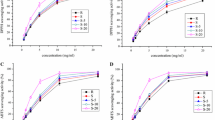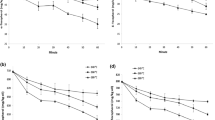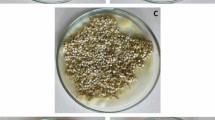Abstract
In this study, the effect of malting process on the antioxidant compounds and antioxidant capacity of quinoa seeds was studied. The optimal germination conditions were germination temperature of 23 °C, degree of steeping of 36% and germination time of 3 days. Under these conditions, green quinoa malt was obtained and subsequently roasted at different temperatures (100–190 °C). Results showed maximum increases in phenolic compounds, Maillard reaction products and antioxidant activity (DPPH radical scavenging and reducing power) in samples roasted at 145 °C for 30 min, whereas a more intensive thermal treatment (190 °C) diminished the levels of all evaluated variables. Thus, malting with a moderate thermal treatment could be considered as an effective process to enrich antioxidants in quinoa grains for their further use as functional ingredient in the production of gluten-free foods and beverages.


Similar content being viewed by others
References
Abugoch James LE (2009) Quinoa (Chenopodium quinoa Willd.): composition, chemistry, nutritional, and functional properties. Adv Food Nutr Res 58:1–31
Bau HM, Villaume C, Nicolas JP, Méjean L (1997) Effect of germination on chemical composition, biochemical constituents and antinutritional factors of soya bean (Glycine max) seeds. J Sci Food Agric 73:1–9
Benzing-Purdie LM, Ripmeester JA, Ratcliffe CI (1985) Effects of temperature on Maillard reaction products. J Agric Food Chem 33:31–33
Bois JF, Winkel T, Lhomme JP, Raffaillac JP, Rocheteau A (2006) Response of some Andean cultivars of quinoa Chenopodium quinoa Willd. to temperature: effects on germination, phenology, growth and freezing. Eur J Agron 25:299–308
Bradford KJ (1995) Water relations in seed germination. In: Kigel J, Galili G (eds) Seed development and germination, 1st edn. Marcell Dekker Inc, New York, pp 352–396
Carciochi RA, Manrique GD, Dimitrov K (2015) Optimization of antioxidant phenolic compounds extraction from quinoa (Chenopodium quinoa) seeds. J Food Sci Technol 52:4396–4404
Carciochi RA, Galván D’Alessandro L, Manrique GD (2016) Effect of roasting conditions on the antioxidant compounds of quinoa seeds. Int J Food Sci Tech 51:1018–1025
Chandrasekara N, Shahidi F (2011) Effect of roasting on phenolic content and antioxidant activities of whole cashew nuts, kernels, and testa. J Agric Food Chem 59:5006–5014
Coghe S, Gheeraert B, Michiels A, Delvaux FR (2006) Development of Maillard reaction related characteristics during malt roasting. J Inst Brew 112:148–156
de Meo B, Freeman G, Marconi O, Booer C, Perretti G, Fantozzi P (2011) Behaviour of malted cereals and pseudo-cereals for gluten-free beer production. J Inst Brew 117:541–546
Devesa JA, Ruiz T, Rodríguez P (1998) Seed germination in wild clovers (Trifolium, Leguminosae) from Southwestern Europe (Spain). Plant Byosist 132:225–232
Dewanto V, Wu X, Liu RH (2002) Processed sweet corn has higher antioxidant activity. J Agric Food Chem 50:4959–4964
Khuwijitjaru P, Plernjit J, Suaylam B, Samuhaseneetoo S, Pongsawatmanit R, Adachi S (2014) Degradation kinetics of some phenolic compounds in subcritical water and radical scavenging activity of their degradation products. Can J Chem Eng 92:810–815
Krahl M, Back W, Zarnkow M, Kreisz M (2008) Determination of optimized malting conditions for the enrichment of rutin, vitexin and orientin in common Buckwheat (Fagopyrum esculentum Moench). J Inst Brew 114:294–299
Lindquist E, Yang Y (2011) Degradation of benzoic acid and its derivatives in subcritical water. J Chromatogr A 1218:2146–2152
Maillard MN, Soum MH, Boivin P, Berset C (1996) Antioxidant activity of barley and malt: relationship with phenolic content. LWT—Food Sci Technol 29:238–244
Mäkinen OE, Zannini E, Arendt EK (2013) Germination of oat and quinoa and evaluation of the malts as gluten free baking ingredients. Plant Foods Hum Nutr 68:90–95
Martins SIFS, Jongen WMF, van Boekel MAJS (2000) A review of Maillard reaction in food and implications to kinetic modelling. Trends Food Sci Tech 11:364–373
Matiacevich SB, Buera MdP (2006) A critical evaluation of fluorescence as a potential marker for the Maillard reaction. Food Chem 95:423–430
Michalska A, Amigo-Benavent M, Zielinski H, del Castillo MD (2008) Effect of bread making on formation of Maillard reaction products contributing to the overall antioxidant activity of rye bread. J Cereal Sci 48:123–132
Nursten HE (2005) Maillard reaction Chemistry, biochemistry and implications. Royal Society of Chemistry, Cambridge
Poonia A, Upadhayay A (2015) Chenopodium album Linn: review of nutritive value and biological properties. J Food Sci Technol 52:3977–3985
Singleton VL, Orthofer R, Lamuela-Raventós RM (1999) Analysis of total phenols and other oxidation substrates and antioxidants by means of folin-ciocalteu reagent. Method Enzymol 299:152–178
Tang Y, Li X, Zhang B, Chen PX, Liu R, Tsao R (2015) Characterisation of phenolics, betanins and antioxidant activities in seeds of three Chenopodium quinoa Willd. genotypes. Food Chem 166:380–388
Tehrani KA, Kersiene M, Adams A, Venskutonis R, De Kimpe N (2002) Thermal degradation studies of glucose/glycine melanoidins. J Agric Food Chem 50:4062–4068
Wahid A, Gelani S, Ashraf M, Foolad MR (2007) Heat tolerance in plants: an overview. Environ Exp Bot 61:199–223
Yahya H, Linforth RST, Cook DJ (2014) Flavour generation during commercial barley operations: a time course study. Food Chem 145:378–387
Yen G, Chen H (1995) Antioxidant activity of various tea extracts in relation to their antimutagenicity. J Agric Food Chem 43:27–32
Zarnkow M, Geyer T, Lindemann B, Burberg F, Back W, Arendt EK, Kreisz S, Gastl M (2008) Optimization of the malting conditions of quinoa. Brauwelt 148:374–379
Acknowledgements
Authors would like to thank the Consejo Nacional de Investigaciones Científicas y Técnicas (CONICET, Argentina) for the parcial support of this project (Postdoctoral fellowship granted to Carciochi).
Author information
Authors and Affiliations
Corresponding author
Ethics declarations
Conflict of interest
The authors declare that they have no conflicts of interest. This work does not contain any studies with human or animal subjects.
Rights and permissions
About this article
Cite this article
Carciochi, R.A., Dimitrov, K. & Galván D´Alessandro, L. Effect of malting conditions on phenolic content, Maillard reaction products formation, and antioxidant activity of quinoa seeds. J Food Sci Technol 53, 3978–3985 (2016). https://doi.org/10.1007/s13197-016-2393-7
Revised:
Accepted:
Published:
Issue Date:
DOI: https://doi.org/10.1007/s13197-016-2393-7




